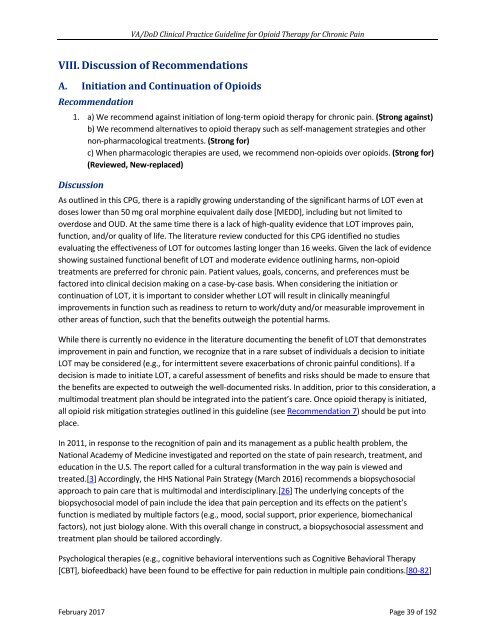VA/DoD CLINICAL PRACTICE GUIDELINE FOR OPIOID THERAPY FOR CHRONIC PAIN
2lfFhbO
2lfFhbO
You also want an ePaper? Increase the reach of your titles
YUMPU automatically turns print PDFs into web optimized ePapers that Google loves.
<strong>VA</strong>/<strong>DoD</strong> Clinical Practice Guideline for Opioid Therapy for Chronic Pain<br />
VIII. Discussion of Recommendations<br />
A. Initiation and Continuation of Opioids<br />
Recommendation<br />
1. a) We recommend against initiation of long-term opioid therapy for chronic pain. (Strong against)<br />
b) We recommend alternatives to opioid therapy such as self-management strategies and other<br />
non-pharmacological treatments. (Strong for)<br />
c) When pharmacologic therapies are used, we recommend non-opioids over opioids. (Strong for)<br />
(Reviewed, New-replaced)<br />
Discussion<br />
As outlined in this CPG, there is a rapidly growing understanding of the significant harms of LOT even at<br />
doses lower than 50 mg oral morphine equivalent daily dose [MEDD], including but not limited to<br />
overdose and OUD. At the same time there is a lack of high-quality evidence that LOT improves pain,<br />
function, and/or quality of life. The literature review conducted for this CPG identified no studies<br />
evaluating the effectiveness of LOT for outcomes lasting longer than 16 weeks. Given the lack of evidence<br />
showing sustained functional benefit of LOT and moderate evidence outlining harms, non-opioid<br />
treatments are preferred for chronic pain. Patient values, goals, concerns, and preferences must be<br />
factored into clinical decision making on a case-by-case basis. When considering the initiation or<br />
continuation of LOT, it is important to consider whether LOT will result in clinically meaningful<br />
improvements in function such as readiness to return to work/duty and/or measurable improvement in<br />
other areas of function, such that the benefits outweigh the potential harms.<br />
While there is currently no evidence in the literature documenting the benefit of LOT that demonstrates<br />
improvement in pain and function, we recognize that in a rare subset of individuals a decision to initiate<br />
LOT may be considered (e.g., for intermittent severe exacerbations of chronic painful conditions). If a<br />
decision is made to initiate LOT, a careful assessment of benefits and risks should be made to ensure that<br />
the benefits are expected to outweigh the well-documented risks. In addition, prior to this consideration, a<br />
multimodal treatment plan should be integrated into the patient’s care. Once opioid therapy is initiated,<br />
all opioid risk mitigation strategies outlined in this guideline (see Recommendation 7) should be put into<br />
place.<br />
In 2011, in response to the recognition of pain and its management as a public health problem, the<br />
National Academy of Medicine investigated and reported on the state of pain research, treatment, and<br />
education in the U.S. The report called for a cultural transformation in the way pain is viewed and<br />
treated.[3] Accordingly, the HHS National Pain Strategy (March 2016) recommends a biopsychosocial<br />
approach to pain care that is multimodal and interdisciplinary.[26] The underlying concepts of the<br />
biopsychosocial model of pain include the idea that pain perception and its effects on the patient’s<br />
function is mediated by multiple factors (e.g., mood, social support, prior experience, biomechanical<br />
factors), not just biology alone. With this overall change in construct, a biopsychosocial assessment and<br />
treatment plan should be tailored accordingly.<br />
Psychological therapies (e.g., cognitive behavioral interventions such as Cognitive Behavioral Therapy<br />
[CBT], biofeedback) have been found to be effective for pain reduction in multiple pain conditions.[80-82]<br />
February 2017 Page 39 of 192


